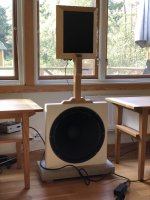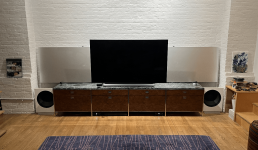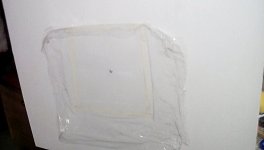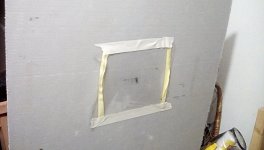That blog does not describe it clearly like the link I had before. The link I had showed pics and clearly stated the felt pads were used on the back of the spine to tune the panel. Its basically damping.Seems they used unmounted felt bobs
Together with wax seals (?)
Read this rather lengthy blog
https://theartofsound.net/forum/archive/index.php/t-59863.html
Basically a felt plug with a hole in it
Eucy
There are things to be learned here, but in a total of 427 pages it should have yielded more. Despite the best efforts of some (esp Christian 👍) to codify results, it has become directionless and I fear it will continue that way.I think my time here is through. I thought I'd found a thread where we would share our builds, but it seems you are obsessed with patents and trying to work out / copy other people's designs, what happened to creative thinking? Trial and error, sharing those failings and successes. Very disillusioned with the ramblings on here. Off to listen to my near perfect panels.
There needs to be more structure to the discussions, and shared projects to test ideas and discuss results.
It is always difficult to motivate a group to achieve a joint outcome, especially a web based one, so I can't see that happening unfortunately.
However @Herb777, methinks you're just a bit quick to condemn.
Eucy
Last edited:
Sorry... It's best I could findThat blog does not describe it clearly like the link I had before. The link I had showed pics and clearly stated the felt pads were used on the back of the spine to tune the panel. Its basically damping.
Given that they are felt cylinders it seems obvious that they were stuffed in the exiter mounting holes.. Is that not so?
Anything you put on the surface of the panel will change the sound as it basically acts as a skin. Thinner the skin the better as it will be more transparent and easier for the sound waves to pass through the skin.
The skin will give the overall tone of the panel. For example if you use paper as the skin of EPS material it will change the sound more like paper tone.
I havent tried cling wrap but I might do it right now just to see what all the hoobla is about. lol
The skin will give the overall tone of the panel. For example if you use paper as the skin of EPS material it will change the sound more like paper tone.
I havent tried cling wrap but I might do it right now just to see what all the hoobla is about. lol
Yeah thats correct.Sorry... It's best I could find
Given that they are felt cylinders it seems obvious that they were stuffed in the exiter mounting holes.. Is that not so?
Maybe I was confusing everyone with that patent ,it is similar but not similar.I believe you're talking at cross purposes here
chdsi is talking about cling wrap tightly wrapped as a surfacing material, Steve is trying a separated membrane with a small air gap which is "pumped" by the air displaced by the driver to provide bass.
This technique has been mentioned in one or more patents
Eucy
Years ago a friend of mine owned a pair of wharfedale picture dml panels.
he said to me at that time, that he preferred the sound of those panels with the pictures in situ ?
I made some measurements ,and it did change the frequency response ,making the panel sound brighter.
But it made the response look rather rough.
It was not until years later that I thought about it some more and started using thin strips of paper over the exciter area.
This gave much better results .
This was for heavier panels , not my eps panels.
The idea is to replace the heavy surface with a light surface membrane that moves freely.
I could see the response from the coil surface area change as I moved the strips of paper over the coil area, this flattened some dips and peaks in the 10k area and above , but only in the voice coil area not the rest of the panel areas.
The cling film is just a slightly different technique , so I am not sure how it will go, so don't get too excited , as it might fail to impress.
The basic idea is to create a separate drive mechanism in the exciter area , operating independently from the rest of the panel.
a passive radiator.
The film should I hope be controlled by the air pressure inbetween the panel surface and the film, similar to the patent I showed.
That's it .
Don't hold your breathes.
Steve.
I need 2 identical panels , for comparisons .
The 6mm proplex seems to be the best bet , as it is a highly damped panel that could do with a little livening up.
I'd compare the sound to a doped paper cone.
Adding a tweeter could solve this, but I want a full range panel with all the bells and whistles.
I will compare the paper strips with the film.
Although the thinner 4mm proplex is louder , it sounds harder, with more coloration.
So I am a little dubious about the 3mm correx and how it will sound, I will hold my judgment for now.
For higher volumes I will have to xo at about 200hz , to prevent my exciters overheating.
I do have a 3mm ply panel I am playing with at the moment,as it is there, I might as well have a listen.
That's it for now.
Steve.
The 6mm proplex seems to be the best bet , as it is a highly damped panel that could do with a little livening up.
I'd compare the sound to a doped paper cone.
Adding a tweeter could solve this, but I want a full range panel with all the bells and whistles.
I will compare the paper strips with the film.
Although the thinner 4mm proplex is louder , it sounds harder, with more coloration.
So I am a little dubious about the 3mm correx and how it will sound, I will hold my judgment for now.
For higher volumes I will have to xo at about 200hz , to prevent my exciters overheating.
I do have a 3mm ply panel I am playing with at the moment,as it is there, I might as well have a listen.
That's it for now.
Steve.
I'm glad that you posted that link to Stanley Rich patent. 🙂Maybe I was confusing everyone with that patent ,it is similar but not similar.
Steve.
He had achieved certain results in those before-personal-computers times. His thinking is quite interesting, even though the air/gasses can be compressed, but 'under dynamic conditions' it might be not be compressed for a moment, that i,s in sudden movements. His idea too was to glue the 'vibration dissipative material' on to the panel surface for 'damping flexural vibrations' on the panel.
What do you think of such materials as in the images to glue to the panel surface, front or both? These sheets were used to cover the shelves, drawers of kitchen cabinets to safeguard the surface.


Thanks Sandasnickaren, you've inspired me to have another go at building a DML speaker, which will be based on the Goebel patent.
I received a quote from Specialized Balsa Wood in the US for 4-off 100-150kg/m3 , 1/16" thick end grain balsa, 12" x12" (standard size sheet cut into 4 for easier shipping to UK). The quote is really very pricey at $246.23 of which shipping is about $75.00. Works out at about £201.00 (say around £240.00 once import fees are included). I'm sure there must be a supplier in Europe, but I can't find one that goes as low as 1/16" thick.
I might just bite the bullet, as don't want to keep trying. I was thinking about crossing over the panel to a 15" open baffle speaker below 160Hz if I can get a good result with the panels. Has anyone used open baffle 15" woofer with a DML panel?
Has anyone used pore filler with Balsa and if so, what did you use?
Thanks in advance.
Did a crude mock up in powerpoint, but would like to build something like this:

I received a quote from Specialized Balsa Wood in the US for 4-off 100-150kg/m3 , 1/16" thick end grain balsa, 12" x12" (standard size sheet cut into 4 for easier shipping to UK). The quote is really very pricey at $246.23 of which shipping is about $75.00. Works out at about £201.00 (say around £240.00 once import fees are included). I'm sure there must be a supplier in Europe, but I can't find one that goes as low as 1/16" thick.
I might just bite the bullet, as don't want to keep trying. I was thinking about crossing over the panel to a 15" open baffle speaker below 160Hz if I can get a good result with the panels. Has anyone used open baffle 15" woofer with a DML panel?
Has anyone used pore filler with Balsa and if so, what did you use?
Thanks in advance.
Did a crude mock up in powerpoint, but would like to build something like this:
Yes.I was thinking about crossing over the panel to a 15" open baffle speaker below 160Hz if I can get a good result with the panels. Has anyone used open baffle 15" woofer with a DML panel?
If you select the right drivers, place them properly, power then sufficiently, and have a large enough room to propagate the bass they can work very well indeed.
I currently use PureAudioProject 15" woofers with my aluminum-honeycomb core | aluminum-skinned DMLs.
PureAudioProject had Eminence optimize a 15" woofer for their open baffle use. Drivers like these can take easily take you down to 29-32hz and can crossover as high as 250 hz, which can prove interesting for small DMLs.
I drive them with Hypex NC122MP amps scavenged from a Hypex FA123 and remounted into a GhentAudio case.
BTW ...
I've got four of these Hypex stereo amp boards that I have now repurposed and consolidated from two previous listening areas. They power the 5 DMLs (front left, center, front right, left rear surround, right rear surround) and the 15" OB woofers in my home theater | primary listening area.
I really think this is overkill for driving my Dayton Audio Thrusters.
I think|suspect DMLs can perform very well with much more modest amplifiers, but I had them.
I tried to get people on this thread to discuss optimal amplification for DMLs, but it didn't go far at the time. Such a discussion would certainly interest me.
You can search my posts in this thread for other pictures of my current woofers in my home theater as well as the single subwoofer I built from a pair of the same drivers suspended, facing each other, and driven in opposite phase.
I love DMLs, but I still like what's possible with OB woofers. That said, I do have one thoughts on a DML or DML-like subwoofer. More to follow in time...
Attachments
That is very expensive, there is no guarantee that the balsa will sound any better than my 1 mm card or veneer panels.Thanks Sandasnickaren, you've inspired me to have another go at building a DML speaker, which will be based on the Goebel patent.
I received a quote from Specialized Balsa Wood in the US for 4-off 100-150kg/m3 , 1/16" thick end grain balsa, 12" x12" (standard size sheet cut into 4 for easier shipping to UK). The quote is really very pricey at $246.23 of which shipping is about $75.00. Works out at about £201.00 (say around £240.00 once import fees are included). I'm sure there must be a supplier in Europe, but I can't find one that goes as low as 1/16" thick.
I might just bite the bullet, as don't want to keep trying. I was thinking about crossing over the panel to a 15" open baffle speaker below 160Hz if I can get a good result with the panels. Has anyone used open baffle 15" woofer with a DML panel?
Has anyone used pore filler with Balsa and if so, what did you use?
Thanks in advance.
Did a crude mock up in powerpoint, but would like to build something like this:
View attachment 1130545
The card panel which you can get for free, is easy to build.
there are recordings of these panels on this forum, have a listen and see what you think.
the balsa links chdsl posted are probably ply of some sort , been there done that.
steve.
I was freezing my nuts off in my cold room today listening to cling film attached to my panels.
thankfully the improvement was worth it.
I was thinking I might try film on my small card and veneer panels ,without the dome?
this also made me think ,if I use two exciters close together will the film prevent the comb filtering between the exciters ?
it's only a thought , but interesting.
while I was experimenting ,I remembered why I did not want to use the 6mm proplex.
The frequency response was so good I did not want to ruin it .
I really wanted to use a panel with a poorer response and try and improve it .
But luckily the response was still pretty good.
Although it is difficult to take a measurement that shows a huge difference as they are pretty much the same, but slightly different.
I did quickly place a aluminium foil which had a plastic coating onto the panel.
This was a lot louder and the response was a little rough.
so different materials will react differently.
cling film is very difficult to handle, especially if like me you have a bunch of bananas for fingers.
I decided to try a thicker polythene film on the 4mm panel which was a lot easier.
I was dragged away at this point, but the sound was still very good, first impressions that is.
Steve.
thankfully the improvement was worth it.
I was thinking I might try film on my small card and veneer panels ,without the dome?
this also made me think ,if I use two exciters close together will the film prevent the comb filtering between the exciters ?
it's only a thought , but interesting.
while I was experimenting ,I remembered why I did not want to use the 6mm proplex.
The frequency response was so good I did not want to ruin it .
I really wanted to use a panel with a poorer response and try and improve it .
But luckily the response was still pretty good.
Although it is difficult to take a measurement that shows a huge difference as they are pretty much the same, but slightly different.
I did quickly place a aluminium foil which had a plastic coating onto the panel.
This was a lot louder and the response was a little rough.
so different materials will react differently.
cling film is very difficult to handle, especially if like me you have a bunch of bananas for fingers.
I decided to try a thicker polythene film on the 4mm panel which was a lot easier.
I was dragged away at this point, but the sound was still very good, first impressions that is.
Steve.
Balsa is already very dense, if you add pore filler you could lose volume spl.Thanks Sandasnickaren, you've inspired me to have another go at building a DML speaker, which will be based on the Goebel patent.
I received a quote from Specialized Balsa Wood in the US for 4-off 100-150kg/m3 , 1/16" thick end grain balsa, 12" x12" (standard size sheet cut into 4 for easier shipping to UK). The quote is really very pricey at $246.23 of which shipping is about $75.00. Works out at about £201.00 (say around £240.00 once import fees are included). I'm sure there must be a supplier in Europe, but I can't find one that goes as low as 1/16" thick.
I might just bite the bullet, as don't want to keep trying. I was thinking about crossing over the panel to a 15" open baffle speaker below 160Hz if I can get a good result with the panels. Has anyone used open baffle 15" woofer with a DML panel?
Has anyone used pore filler with Balsa and if so, what did you use?
Thanks in advance.
Did a crude mock up in powerpoint, but would like to build something like this:
View attachment 1130545
Some pictures of the test panels, very basic but it works.
The first picture is the 4mm panel , I used a little blu-tack in the middle to pull the film away from the panel, what effects this had on the film I do not yet know ?
Picture 2 ,I used what I had at hand to make the air gap bigger on the 6mm panel.
Not even sure how necessary it is to seal the air gap as it tended to work anyway ?
Work in progress.
Steve.
The first picture is the 4mm panel , I used a little blu-tack in the middle to pull the film away from the panel, what effects this had on the film I do not yet know ?
Picture 2 ,I used what I had at hand to make the air gap bigger on the 6mm panel.
Not even sure how necessary it is to seal the air gap as it tended to work anyway ?
Work in progress.
Steve.
Attachments
I've also tried cling wrap on my DML panels (covering the whole panel front and back) and it basically comes down to personal preference.
Like I mentioned before anything you put on the surface of said material (in my case EPS) the "SKIN", will change the tone.
Its no different in conventional cone drivers in which they use different types of materials. Some use paper, treated paper, alumin/mag, kevlar, fiberglass, ceramic, titanium, beryllium, carbon fiber, ceramic, poly, etc etc.
What all skins do on a EPS panel is reduce the ringing/echo effect to certain degrees depending on said skin material used. This will make the EPS panels sound less diffused and more accurate sounding. Anything touching the EPS panel will act as damping.
Again the skin as to be very thin and light and or transparant. Which reminds me of one material that I use which is plain ol speaker grill "CLOTH". I buy mine from P.E.
Like I mentioned before anything you put on the surface of said material (in my case EPS) the "SKIN", will change the tone.
Its no different in conventional cone drivers in which they use different types of materials. Some use paper, treated paper, alumin/mag, kevlar, fiberglass, ceramic, titanium, beryllium, carbon fiber, ceramic, poly, etc etc.
What all skins do on a EPS panel is reduce the ringing/echo effect to certain degrees depending on said skin material used. This will make the EPS panels sound less diffused and more accurate sounding. Anything touching the EPS panel will act as damping.
Again the skin as to be very thin and light and or transparant. Which reminds me of one material that I use which is plain ol speaker grill "CLOTH". I buy mine from P.E.
Last edited:
No they're not ply, just normal balsa but not end grain. Eric has used this type of balsa - I would try this first before opting for the expensive end grain - I personally doubt the difference will be noticeable/measurable/worth the cost.That is very expensive, there is no guarantee that the balsa will sound any better than my 1 mm card or veneer panels.
The card panel which you can get for free, is easy to build.
there are recordings of these panels on this forum, have a listen and see what you think.
the balsa links chdsl posted are probably ply of some sort , been there done that.
steve.
Or try aramid paper (Nomex) - probably no more expensive ?? (https://www.easycomposites.co.uk/nomex-aramid-honeycomb)
Or try to find some structural foams like Rohacell, Airex, Divinycell etc
Eucy
Last edited:
Yes, I have used Eminence delta lite 15” with very good result. It’s a small baffle so iI used dsp to crank up the base a bit.Thanks Sandasnickaren, you've inspired me to have another go at building a DML speaker, which will be based on the Goebel patent.
I received a quote from Specialized Balsa Wood in the US for 4-off 100-150kg/m3 , 1/16" thick end grain balsa, 12" x12" (standard size sheet cut into 4 for easier shipping to UK). The quote is really very pricey at $246.23 of which shipping is about $75.00. Works out at about £201.00 (say around £240.00 once import fees are included). I'm sure there must be a supplier in Europe, but I can't find one that goes as low as 1/16" thick.
I might just bite the bullet, as don't want to keep trying. I was thinking about crossing over the panel to a 15" open baffle speaker below 160Hz if I can get a good result with the panels. Has anyone used open baffle 15" woofer with a DML panel?
Has anyone used pore filler with Balsa and if so, what did you use?
Thanks in advance.
Did a crude mock up in powerpoint, but would like to build something like this:
View attachment 1130545
It was easy to integrate it to the panel.
Low WAF though…
I crossed it over at 300 Hz to reduce the floor reflection cancellation.

- Home
- Loudspeakers
- Full Range
- A Study of DMLs as a Full Range Speaker



